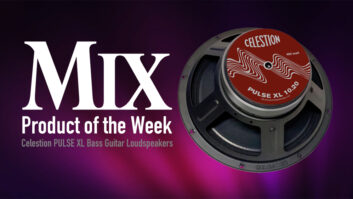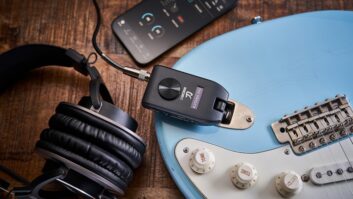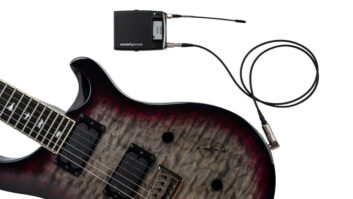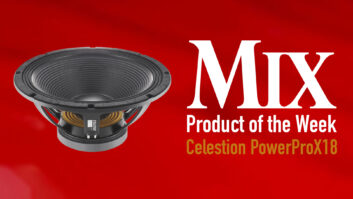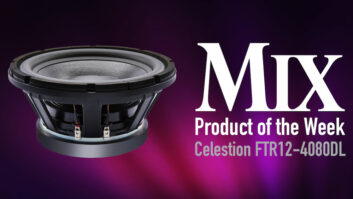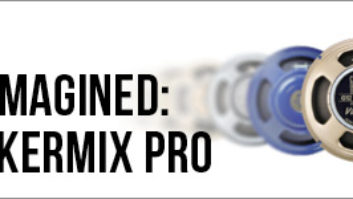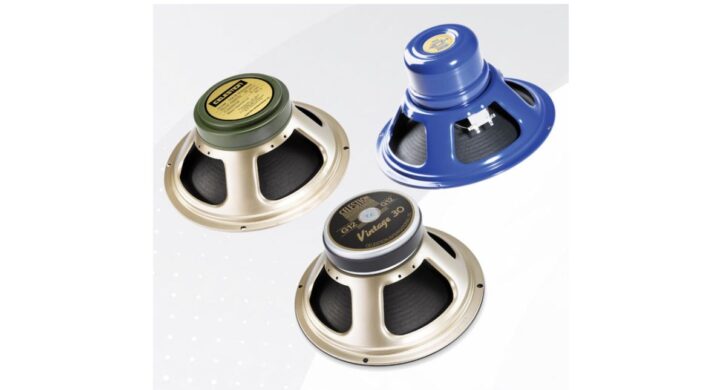
Anaheim, CA (April 12, 2023) — Celestion, the premier manufacturer of guitar and bass loudspeakers, will showcase their three most iconic guitar speakers — the Celestion Blue, the Greenback, and the Vintage 30 — at this year’s NAMM Show at Booth 6602. One year before their 100th birthday, the company is excited to honor the three drivers that helped launch their worldwide reputation as “the voice of rock and roll.”
The Blue
The Celestion Blue began life in the late 1950s as alternative to the G12 radiogram speakers then used by storied guitar amp maker Vox, who sought more power handling for their new AC30 combo amplifier. Legendary Celestion engineer Les Ward worked with Vox’s Derek Underdown on three key modifications. In a then-revolutionary process, the duo first strengthened the driver surround, which was the part most vulnerable to physical stress. Second, they changed the voice coil windings from aluminum to copper, which made them more tolerant to heat at high gain. Third, they strengthened the termination wires to better cope with the high-amplitude cone movement the amp could produce.
The result then was a speaker known as the T530, which was rated at 15 watts, and featured an alnico (aluminum, nickel, and cobalt) alloy magnet. The speaker was painted azure blue at the behest of Vox owner Tom Jennings and was initially badged the Vox Blue for installation in the AC30 amp, which secured its place in guitar tone history.
The Blue took a hiatus beginning in the 1970s due to the high cost of alnico, but when the alloy again became affordable, Celestion would reissue the speaker for their 70th anniversary in 1994 this time labelled as the “Celestion Blue” and to this day it is still hand-built in exactly the same way. The Blue found favour with notable guitarists like George Harrison and Brian May due to its glorious, dampened attack, warm lows, mellow upper-mids and brilliant bell-like top-end.
With 15 watts into 8 or 15ohms and 100dB sensitivity, and a frequency response from 75 to 5,000 Hz, the Celestion Blue, when coupled with a suitable amplifier, evokes rich definition and develops beautiful musical compression when pushed. Tone enthusiasts worldwide hail the Blue as the benchmark for guitar speaker perfection.
The Greenback
As a result of the increasing cost of Alnico in the mid-1960s, Celestion began to use an iron-based ceramic in most speakers. Enter the heavy magnet G12H and medium magnet G12M, designated the T1220 (8-ohm) and T1221 (16-ohm). The model name G12M referred to both, but thanks to the green plastic cover over the magnet assembly, a more affectionate moniker stuck even better: The Greenback.
The first G12M speakers were rated at 20 watts and upgraded to 25 watts approximately two years later, meaning one could install them with confidence in a 4×12″ cabinet intended for use with a 100-watt amp head. This made them the go-to for Marshall amps. Though the Greenback had already become the Marshall speaker of choice after being deployed in Marshall’s 1962 2×12″ rig, the most famous of which was Eric Clapton’s “Bluesbreaker.” Driven just on the edge of distortion, the G12M produced a warm low end; a rich, vocal-like midrange; and a detailed but delicate treble. This amp-speaker pairing also defined the sound of many of Jimi Hendrix’s early recordings, and Angus Young remains a greenback fan since the early days of AC/DC.
Though it has evolved over the years, the G12M Greenback retains its sought-after character.
The Greenback is voiced with extra broad midrange attack and restrained high end that fosters punchy chords and searing leads without fizz. Driven just on the edge of distortion, it produces a warm low end; a rich, vocal-like midrange; and a detailed but delicate treble. Rated at 25 watts (at 8 or 16 ohms) and offering 98dB of sensitivity and frequency response of 75 to 5,000 Hz, it is voiced with a broad midrange attack and high-end roll-off that fosters punchy chords and searing leads. It is as at home in single-speaker amps as in multi-driver, high-gain rock configurations.
The Vintage 30
The increasing “heaviness” of rock and metal from the 1970s to the mid-’80s demanded more power, inspiring the G12-65, G12T-75, G12K-85 and S12-150 “Sidewinder”. Thanks to the heat resistant materials used in their construction, these speakers were considered to be more “modern” sounding drivers. By the mid-’80s, however, guitarists and amp manufacturers craved the sound of the ‘good old days’. Marshall’s amp engineer Steve Grindrod requested a new speaker that had the magincal tone of the old alnico speakers of the ‘60s. with that brief in mind, Celestion engineer Ian White went on to create a speaker that combined the tone of the old speakers with the durability of the new.
White analyzed an original alnico speaker using a process called Laser Doppler Interferometry. “The laser was especially good at looking at cones,” remembers White. “We used that data to form a precise model of the vintage speaker’s characteristics.” This led White to create a new coil assembly using a modern material, more commonly used for hi-fi speakers, with mass and tonal properties similar to the paper voice coil of the vintage alnico speakers, but with a much better power handling.
The resultant speaker was the Marshall Vintage which coupled Celestion’s “H” magnet — the closest in performance to the alnico — with the new voice coil, delivering the higher power handling required (70-watt), but still with the vintage musicality of a new-old-stock speakers that might be rated much lower.
Originally targeted for use with Marshall’s Studio 15 amp, the speaker found its way into all manner of stacks and combo amps after a grace period of Marshall exclusivity, it became a Celestion standard produce and was renamed the Vintage 30 (and given a slightly lower, 60-watt power rating). Players who have embraced its tone include Peter Frampton, Slash, Steve Morse, and Steve Vai.
With a frequency response of 70 to 5,000 Hz and 100dB sensitivity, the Vintage 30’s rich bass, singing midrange, and precise treble make it Celestion’s most revealing speaker in the eyes (and ears) of many users. It is ideal for capturing the tonal complexities of which hand-wired boutique amps are capable; likewise, for serving up a lovely 3D crunch in two- or four-speaker setups. This has made the Vintage 30 one of the most popular Celestion loudspeakers, with sales to date exceeding 1.5 million units.
Legacy Meets Innovation
Celestion will exhibit these three icons and more in Booth 6602 at the 2023 NAMM show, held April 13 through 15 at the Anaheim Convention Center in Anaheim, California.
“Celestion are obviously proud of all our products,” says Nigel Wood, Managing Director at Celestion. “But the iconic Celestion Blue, Greenback, and Vintage 30 are the ones most often used as the benchmark for Celestion tone and for guitar tone in general. This is why we wanted to focus this year’s NAMM exhibit on giving them the place in history they deserve.”
About Celestion and Celestion Guitar Speakers
An important element to essential British guitar tone since the birth of Rock & Roll, Celestion Guitar Speakers are famous for their lively and vocal midrange character with plenty of sparkle and chime. With worldwide headquarters in Ipswich, England, Celestion design, develop and manufacture premium guitar and bass loudspeakers, and high-quality professional audio drivers for sound reinforcement. These world-renowned speakers are used onstage and in clubs, theatres, and other venues the world over. Since 2017, Celestion Digital has offered the tones of the company’s legendary guitar and bass speakers as downloadable impulse responses that work with most modern guitar effects processors and amp-top load boxes. Contact Celestion at [email protected] and visit us on Facebook at www.facebook.com/celestion.
